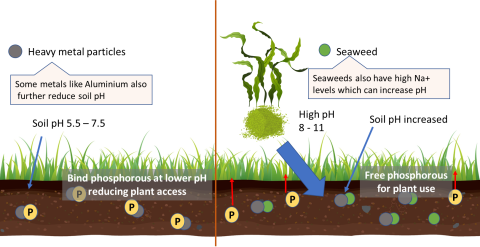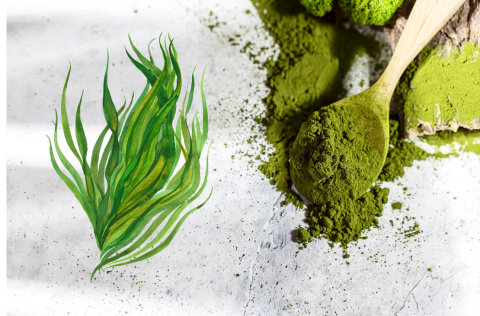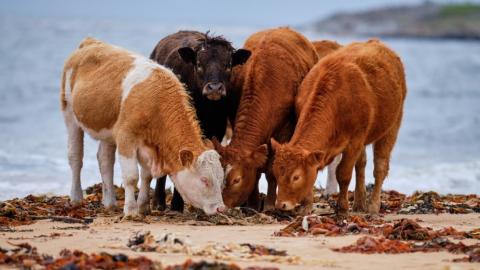20 October 2022
Dr David Cutress: IBERS, Aberystwyth University.
- Seaweeds have long had suggested benefits for agricultural use
- Research suggests green seaweeds to be beneficial for soil/plant amendments and red seaweeds to have some potential for animal feeds
- To be able to include at meaningful levels, the production and supply chain of seaweeds needs to be researched and developed further
Seaweeds
Seaweeds are algae, specifically, they are macroalgae and despite performing many of the same functions as plants they are not plants. For this reason, you may sometimes see seaweed referred to as non-vascular plants but unlike plants, these species absorb nutrients which they use for photosynthesis directly through their cell walls. They also lack stems, roots, xylems and many other specialised plant structures. The three main groups of seaweeds are green, red and brown and their colours come from the combination of chlorophyll and other accessory photosynthetic pigments found within each species, for example, red seaweeds have phycoerythrin and phycocyanin pigments for absorbing light that reaches deeper into the ocean and the brown seaweeds have the pigment fucoxanthin. Seaweeds have long been utilised by people for many reasons including as a medicinal source with more modern research finding the specific elements within seaweeds that lead to its various functions. Some of the roles of seaweeds in general include;
|
|
|
|
|
|
|
|
|
|
|
|
|
|
|
But within agriculture, it is the highlighted roles that are of most interest.
Seaweeds and agriculture
The high level of interest in seaweeds and seaweed extracts for use in plant growth and agriculture is clear when we observe that the journal article from 1992 titled ‘Seaweed extracts in agriculture and horticulture: a review’ has been cited almost 350 times in subsequent papers. But before these scientific perspectives, the benefits of seaweeds were suggested throughout common historic practices of coastal farming communities. This included the grazing of harvested seaweed for livestock as a supplementary food source and the utilisation of beach-cast seaweed as manure and fertiliser for the land, as far back as Roman times. As well as native macroalgae species vital to freshwater and marine ecosystems there is a significant impact surrounding invasive algae. As human activity impacts waterways and marine systems this often causes eutrophication where the overabundance of nutrients leads to increased algal growth and invasion of non-native species. These increased levels of algae require collection and removal for ecosystems to return to normal and the utilisation of this ‘waste’ could allow some environmentally focused circularity. Though of course, this circularity is finite if agriculture and other water pollution sources are targeted for reduction and removal in the long run.
Direct fertiliser and land application
Generally, where seaweeds are applied to the land they are applied whole, finely chopped, powdered or in aqueous extract forms.
Benefits
Seaweed (or its extracts) incorporated as a soil supplement or fertiliser is said to have a range of potential uses within arable and horticultural systems. It can effectively be a carbon-neutral fertiliser additive similar to other green manures. Whilst seaweeds are known for being lower in nitrogen (N) and phosphorus (P) they do tend to be higher in potassium (K). Seaweeds directly add plant rate limiting elements into soils but they can also function as plant biostimulants as they contain hormones that trigger increased growth and nutrient uptake efficiencies in plants. Auxins, cytokinins, gibberelins, abscisic acid and ethylene are all found in seaweeds and they can act upon plant growth, ageing, cell division, germination, and stress management. Whilst there is a lack of meta-analyses of the impacts of different macroalgae application effects on crop yields and nutrient requirements, multiple studies suggest beneficial impacts.
|
Crop |
Positive impacts |
Paper |
|
Marigolds |
~40% increase in flower weight 50% less chemical fertiliser required |
|
|
Tomato seedlings |
Increased plumule length, radicle length, increased dry weight, increased shoot length and plant height, worked better as soil amendment than foliar spray |
|
|
Bean |
Increased germination |
|
|
Broccoli |
Increase in antioxidant activity, flavonoids, phenolic and isothiocynate, increases in stem diameter, leaf area, biomass, enhanced early growth and reduced white blister (Albugo candida) |
|
|
Mung Bean |
Increase in total protein, total carbohydrate and, total lipid; increase in shoot and root length |
|
|
Watermelon |
Increase in yield |
|
|
Onion |
Increase in yield and reduced severity of downy mildew |
Across the three groups of seaweed, research suggests that green macroalgae have the most promise for soil supplementation as they contain components that can promote the removal of detrimental soil and plant fungi and pathogens (such as moulds and mildews) and drive increased plant defence. They have also been shown to have potential roles in preventing the damage from plant nematode species on crops which could act as a unique organic replacement to soil-applied nematicides.
Seaweed and seaweed products including biochar are known to have a neutral to alkaline pH which through direct application to soils can act to amend soil pH as a liming agent. Other outcomes causing this liming function seen within seaweed trials have been associated with their levels of sodium (Na+) as well as high calcium (Ca) and alginate levels, which combined, are involved in the seaweed’s ability to bioaccumulate heavy metals. This removal of metals can impact pH by removing access to particles from soils which would normally cause increased acidity. Application of seaweed to contaminated degraded lands could also help with the removal of heavy metals such as aluminium (Al) thereby blocking/lowering the ability of Al to bind to plant limiting nutrients like phosphorus. This could in certain systems further help to reduce fertiliser requirements.
Furthermore, one of the properties of commercial seaweed additives that is often quoted is that their alginates have structural impacts on soils, forming complexes that help to absorb water improving water retention, increasing aeration and soil pore functionality and generally improving soil structure. This links with the interest surrounding hydrogel application on soils for unique slow-releasing fertiliser benefits along with improved moisture levels around plants in soils.
Barriers to use
Seaweed biomass needs more supply chain and market considerations in a lot of instances with direct site-based production and subsequent use ensuring that the material does not ferment and degrade, leading to it becoming just another form of waste that can have detrimental impacts including the release of detrimental gasses such as hydrogen sulphide. One method that can prevent this nutrient wastage and stabilise the beneficial aspects of seaweeds is to use composting. In one set of experiments using green seaweeds composted with sugarcane wastes re-applied to subsequent sugarcane growth, it was found that high seaweed composts led to four times higher aboveground biomass than commercial composts lacking seaweed. Even in studies where insignificant impacts on yield and weight of biomass occurred, it was still noted that benefits in the levels of micro and macro elements (such as boron, iron, copper, zinc, calcium, sulphur and potassium) were seen within the plant biomass harvested.
Sulphur compounds in high levels in some seaweeds may act in opposition to the liming ability when added to soils if anaerobic conditions are prominent (soils aren’t aerated) as this can lead to microbial oxidation of sulphur to sulphates.
Feed for methane reduction
The other area where seaweeds have received a great deal of attention within agriculture is their suggested roles in livestock feed, with much research and media coverage focusing on their suggested environmental impacts.
Benefits
Seaweeds can be high in protein (up to 47% weight in some cases) whilst others have beneficial omega-fatty acid levels. This protein level aspect makes them desirable for consideration as an alternative protein source for livestock. When this is combined with the presence of naturally occurring compounds in seaweeds which impact the production of methane it is easy to see the interest. Seaweeds contain bromoform which acts to inhibit the final step in methane formation due to organisms in the rumen, and this is thought to be the main mechanism of action. Red seaweed species are known to have higher bromoform and similarly functional bromochloromethane levels. Across studies methane reductions of up to 100% (over short study timeframes) and 98% (over longer 90-day timeframes) have been observed, whilst other studies have noted far less reduction or even, in a few cases, some minor increase in methane level in the short term. These environmental impacts of seaweed as feed are of high interest for future net-zero strategies and as such we are likely to see more research to try and untangle these conflicting results in the future through large-scale trials. Alongside methane impacts other reported feed effects have included live weight gain improvements and dry matter ingestion reductions.
Barriers to use
As noted above in the benefits of seaweed for fertiliser and soil application, seaweeds are very good at accumulating heavy metals, this is also true in aquatic environments before harvest. For this reason, testing and sourcing of seaweeds for livestock ingestion may need considerations to ensure any rations do not lead to impactful levels of adverse metals making their way into the animal’s body. Similarly, iodine toxicity for livestock as well as its incorporation into meat and milk may also be a barrier of consideration for the use of seaweed in feeds. High levels of iodine in seaweeds have been noted in one experiment to lead to milk produced with iodine levels as high as 3 mg/L which would make the safe tolerable limit of milk for adults around 300 ml a day and for children 1 litre of milk would contain over 15 times the suggested tolerable level. Whilst this is just one study it is enough to indicate that more research may be required.
Another possible barrier to use in livestock is the indication that there is a low level of palatability with seaweed inclusion in feed leading to reduced feed intake issues. Whilst many studies have shown inclusion rates up to 20% in sheep trials the average inclusion rate (across 10+ studies) was 12.8% (but ranged as low as 0.006%). This could be an area where specific extracted compounds from seaweed fare better than the whole product itself.
Other seaweed considerations
A big consideration surrounding seaweed utilisation is its potential value as a replacement for environmentally damaging fossil fuels. Seaweeds offer an interesting option for biomass growth for biofuel production for a few different reasons. Firstly, similar to plant-based biofuel options, seaweeds would be essentially carbon neutral. They also have promising biomass output levels and cost-effectiveness in their growth, but importantly they don’t impact land use change and don’t compete directly with any agricultural land application. This means that there can be no argument that it would be better to farm something else in place of seaweed due to the food vs fuel argument. This role could, however, be in direct competition for the supply of macroalgae for agricultural applications, unless excess was produced or methods were improved to separate the agriculturally important compounds from the biofuel beneficial biomass in an environmentally and cost-effective way. Furthermore, making seaweed incorporation feasible on a large scale would require direct seaweed farming across Europe to avoid associated import issues. Several publications have noted that there would likely be impacts on biodiversity associated with seaweed farming at such scales, though, as yet the true nature of impacts is unknown with some studies showing limited impacts and others showing a reduction in fish species biodiversity due to disturbances. This would require much more targeted experimentation before large-scale supplies could be achieved safely.
Artificial growth and farming of seaweed is a growing area of aquaculture with figures suggesting it accounts for ≥27% of total marine aquaculture production. Despite this, it is clear that much more research and development is needed on what species to farm/culture and how best to do this in the UK to have the level of resources for larger-scale incorporation into agriculture. Currently, the vast majority of seaweed farming occurs in Asia making export and import factors a huge consideration. The prospects of seaweed farming are high as these systems of farming don’t compete with arable land or freshwater aquaculture and their growth has been linked with carbon mitigation strategies.
Seaweed removal for use in agriculture could serve other environmental and economic benefits. One way this might benefit is that large-scale beach-cast of seaweeds are often associated with negative implications for tourism due to the appearance and smell during fermentation. As such having mechanisms to collect this seaweed for beneficial agricultural purposes or any other beneficial purposes could go towards boosting the local economies of coastal regions.
The compounds found within seaweeds are already discussed for their direct roles in pathogen control and biocidal activities. But another area of interest is in chemically altering these compounds to have improved effects, with much research suggesting interesting antimicrobial roles following modification. These could ultimately play roles in improving livestock treatment options and reducing the impact of antimicrobial resistances which continue to be of concern to the industry.
Summary
Seaweed’s and macroalgae’s agricultural use could have a role in circularity, particularly in coastal regions or where farming practices increase eutrophication of nearby water sources and this leads to increased waterway macroalgal growth. Rather than allowing this to impact ecosystems, harvesting it for application back onto agricultural soils or feeds could be beneficial. For soil application, consideration of seaweed supply chains needs evaluating to ensure the logistics and cost (economic and environmental) vs value benefits of the application are fully understood. Furthermore, seaweed appears to work better in healthier soils where strategies are in place to reduce the levels of anaerobic microbial activity. This suggests it would work well in combination with sustainable practices such as cover cropping and silvoarable farming. Macroalgae for livestock feed on the other hand have potential as an alternative protein source with some interesting environmental impacts that need further evaluation in large-scale trials. Green seaweed species show promise for soil application whilst red seaweed species show more promise for livestock use avoiding competition between these two products.
If you would like a PDF version of the article, please contact heledd.george@menterabusnes.co.uk




